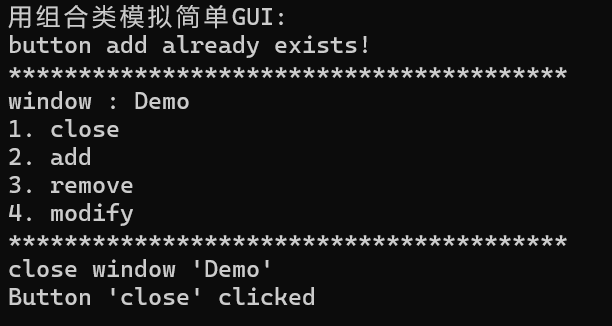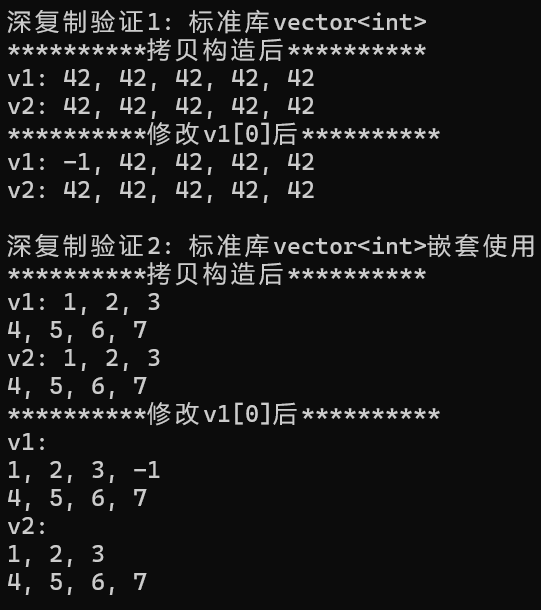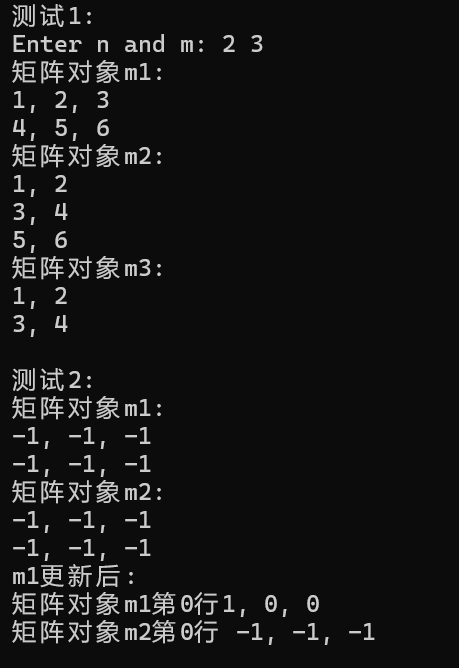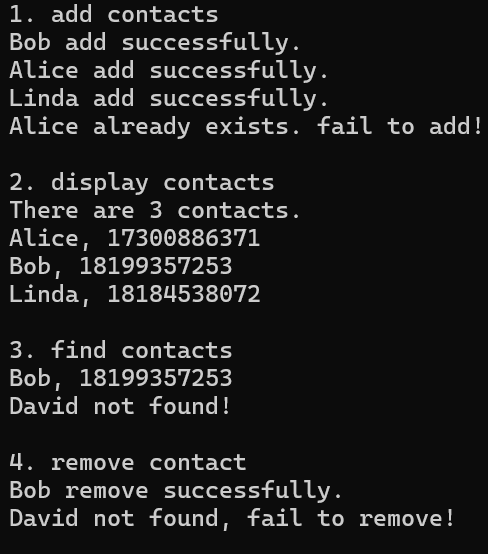OOP-实验3
一、任务1
1.源代码
button.hpp
#pragma once
#include <iostream>
#include <string>
class Button
{
public:
Button(const std::string &label_);
const std::string& get_label() const;
void click();
private:
std::string label;
};
Button::Button(const std::string &label_): label{label_}
{
}
inline const std::string& Button::get_label() const
{
return label;
}
inline void Button::click()
{
std::cout << "Button '" << label << "' clicked\n";
}
window.hpp
#pragma once
#include <iostream>
#include <vector>
#include <algorithm>
#include "button.hpp"
class Window
{
public:
Window(const std::string &title_);
void display() const;
void close();
void add_button(const std::string &label);
void click_button(const std::string &label);
private:
bool has_button(const std::string &label) const;
private:
std::string title;
std::vector<Button> buttons;
};
Window::Window(const std::string &title_): title{title_}
{
buttons.push_back(Button("close"));
}
inline void Window::display() const
{
std::string s(40, '*');
std::cout << s << std::endl;
std::cout << "window : " << title << std::endl;
int cnt = 0;
for(const auto &button: buttons)
std::cout << ++cnt << ". " << button.get_label() << std::endl;
std::cout << s << std::endl;
}
inline void Window::close()
{
std::cout << "close window '" << title << "'" << std::endl;
click_button("close");
}
inline bool Window::has_button(const std::string &label) const
{
for(const auto &button: buttons)
if(button.get_label() == label)
return true;
return false;
}
inline void Window::add_button(const std::string &label)
{
if(has_button(label))
std::cout << "button " << label << " already exists!\n";
else
buttons.push_back(Button(label));
}
inline void Window::click_button(const std::string &label)
{
for(auto &button:buttons)
if(button.get_label() == label)
{
button.click();
return;
}
std::cout << "no button: " << label << std::endl;
}task1.cpp
#include "window.hpp"
#include <iostream>
void test()
{
Window w("Demo");
w.add_button("add");
w.add_button("remove");
w.add_button("modify");
w.add_button("add");
w.display();
w.close();
}
int main()
{
std::cout << "用组合类模拟简单GUI:\n";
test();
}2、运行结果截图

3、问题1:这个范例中,Window和Button是组合关系吗?
是组合关系,window类中有button对象,button类的存在依赖window类,window可以管理button,决定button的存在与否。
4、问题2: bool has_button(const std::string &label) const; 被设计为私有。 思考并回答:
(1)若将其改为公有接口,有何优点或风险?
优点:可以让外部直接查询按钮,提高效率
风险:破坏了类的封装性,可能导致接口不必要的使用
(2)设计类时,如何判断一个成员函数应为 public 还是 private?(可从“用户是否需要”、“是否仅为内部实现细节”、“是否易破坏对象状态”等角度分析。)
用户是否需要:如果用户需要这些函数直接完成某些操作可以设为public,
是否仅为内部实现细节:如果涉及类内部的细节,不涉及外部操作,可设为private,
是否易破坏对象状态:如果会破坏对象的状态,需要保护类的内部将其设置为public提高类的封装性。
问题3:
性能:接口1引用内部,性能较高,可以避免字符串的拷贝
安全性:接口1的字符串如果被修改,会直接影响对象内部信息,安全性较低;接口2返回副本,安全性高。
问题4:把代码中所有 xx.push_back(Button(xxx)) 改成 xx.emplace_back(xxx) ,观察程序是否正常运行;查阅资料,回答两种写法的差别
可以,push_back先创建了button对象,然后进行拷贝到vevtor中的操作;emplace_back是直接在vector中分配内存创建对象。
二、任务2
1、源代码
task2.cpp
#include <iostream>
#include <vector>
void test1();
void test2();
void output1(const std::vector<int> &v);
void output2(const std::vector<int> &v);
void output3(const std::vector<std::vector<int>>& v);
int main()
{
std::cout << "深复制验证1: 标准库vector<int>\n";
test1();
std::cout << "\n深复制验证2: 标准库vector<int>嵌套使用\n";
test2();
}
void test1()
{
std::vector<int> v1(5, 42);
const std::vector<int> v2(v1);
std::cout << "**********拷贝构造后**********\n";
std::cout << "v1: "; output1(v1);
std::cout << "v2: "; output1(v2);
v1.at(0) = -1;
std::cout << "**********修改v1[0]后**********\n";
std::cout << "v1: "; output1(v1);
std::cout << "v2: "; output1(v2);
}
void test2()
{
std::vector<std::vector<int>> v1{{1, 2, 3}, {4, 5, 6, 7}};
const std::vector<std::vector<int>> v2(v1);
std::cout << "**********拷贝构造后**********\n";
std::cout << "v1: "; output3(v1);
std::cout << "v2: "; output3(v2);
v1.at(0).push_back(-1);
std::cout << "**********修改v1[0]后**********\n";
std::cout << "v1: \n"; output3(v1);
std::cout << "v2: \n"; output3(v2);
}
void output1(const std::vector<int> &v)
{
if(v.size() == 0)
{
std::cout << '\n';
return;
}
std::cout << v.at(0);
for(auto i = 1; i < v.size(); ++i)
std::cout << ", " << v.at(i);
std::cout << '\n';
}
void output2(const std::vector<int> &v)
{
if(v.size() == 0)
{
std::cout << '\n';
return;
}
auto it = v.begin();
td::cout << *it;
for(it = v.begin()+1; it != v.end(); ++it)
std::cout << ", " << *it;
std::cout << '\n';
}
void output3(const std::vector<std::vector<int>>& v)
{
if(v.size() == 0)
{
std::cout << '\n';
return;
}
for(auto &i: v)
output2(i);
}2、运行结果截图

3、问题1:测试模块1中这两行代码分别完成了什么构造? v1、v2 各包含多少个值为 42 的数据项?
分别完成了构造函数和拷贝构造函数,v1包含5个,v2包含5个。
4、问题2:测试模块2中这两行代码执行后, v1.size()、v2.size()、v1[0].size()分别是多少?
v1.size()=2
v2.size()=2
v1[0].size()=3
5、问题3:测试模块1中,把v1.at(0) = -1;写成v1[0] = -1;能否实现同等效果?两种用法有何区别?
可以。at()会检查越界问题,安全性较高
6、问题4
(1)可以,前者是赋值,后者是索引输出最后一个元素
(2)避免了拷贝和内存分配,同时限制了对象的修改
7、问题5
(1)深复制
(2)当 v是vector 时,v.at(0)返回值类型是什么? int&
当v是const vector时,v.at(0)返回值类型又是什么? const int&
据此推断 at()是否必须提供带 const 修饰的重载版本? 必须
三、任务3
1、源代码
vectorint.hpp
#pragma once
#include <iostream>
// 动态int数组对象类
class vectorInt{
public:
vectorInt();
vectorInt(int n_);
vectorInt(int n_, int value);
vectorInt(const vectorInt &vi);
~vectorInt();
int size() const;
int& at(int index);
const int& at(int index) const;
vectorInt& assign(const vectorInt &vi);
int* begin();
int* end();
const int* begin() const;
const int* end() const;
private:
int n;
// 当前数据项个数
int *ptr; // 数据区
};
vectorInt::vectorInt():n{0}, ptr{nullptr} {
}
vectorInt::vectorInt(int n_): n{n_}, ptr{new int[n]} {
}
vectorInt::vectorInt(int n_, int value): n{n_}, ptr{new int[n_]} {
for(auto i = 0; i < n; ++i)
ptr[i] = value;
}
vectorInt::vectorInt(const vectorInt &vi): n{vi.n}, ptr{new int[n]} {
for(auto i = 0; i < n; ++i)
ptr[i] = vi.ptr[i];
}
vectorInt::~vectorInt() {
delete [] ptr;
}
int vectorInt::size() const {
return n;
}
const int& vectorInt::at(int index) const {
if(index < 0 || index >= n) {
std::cerr << "IndexError: index out of range\n";
std::exit(1);
}
return ptr[index];
}
int& vectorInt::at(int index) {
if(index < 0 || index >= n) {
std::cerr << "IndexError: index out of range\n";
std::exit(1);
}
return ptr[index];
}
vectorInt& vectorInt::assign(const vectorInt &vi) {
if(this == &vi)
return *this;
int *ptr_tmp;
ptr_tmp = new int[vi.n];
for(int i = 0; i < vi.n; ++i)
ptr_tmp[i] = vi.ptr[i];
delete[] ptr;
n = vi.n;
ptr = ptr_tmp;
return *this;
}
int* vectorInt::begin() {
return ptr;
}
int* vectorInt::end() {
return ptr+n;
}
const int* vectorInt::begin() const {
return ptr;
}
const int* vectorInt::end() const {
return ptr+n;
}task3.cpp
#include "vectorInt.hpp"
#include <iostream>
void test1();
void test2();
void output1(const vectorInt &vi);
void output2(const vectorInt &vi);
int main() {
std::cout << "测试1: \n";
test1();
std::cout << "\n测试2: \n";
test2();
}
void test1() {
int n;
std::cout << "Enter n: ";
std::cin >> n;
vectorInt x1(n);
for(auto i = 0; i < n; ++i)
x1.at(i) = (i+1)*10;
std::cout << "x1: "; output1(x1);
vectorInt x2(n, 42);
vectorInt x3(x2);
x2.at(0) = -1;
std::cout << "x2: "; output1(x2);
std::cout << "x3: "; output1(x3);
}
void test2() {
const vectorInt x(5, 42);
vectorInt y;
y.assign(x);
std::cout << "x: "; output2(x);
std::cout << "y: "; output2(y);
}
// 使用xx.at()+循环输出vectorInt对象数据项
void output1(const vectorInt &vi) {
if(vi.size() == 0) {
std::cout << '\n';
return;
}
std::cout << vi.at(0);
for(auto i = 1; i < vi.size(); ++i)
std::cout << ", " << vi.at(i);
std::cout << '\n';
}
// 使用迭代器+循环输出vectorInt对象数据项
void output2(const vectorInt &vi) {
if(vi.size() == 0) {
std::cout << '\n';
return;
}
auto it = vi.begin();
std::cout << *it;
for(it = vi.begin()+1; it != vi.end(); ++it)
std::cout << ", " << *it;
std::cout << '\n';
}2、运行结果截图

3、问题1:当前验证性代码中,vectorInt 接口assign 实现是安全版本。如果把assign 实现改成版本2,逐条指出版本 2存在的安全隐患和缺陷。(提示:对比两个版本,找出差异
化代码,加以分析)
版本2将deleta置于new前面,如果内存不足会泄露
4、问题2:当前验证性代码中,重载接口at内部代码完全相同。若把非 const 版本改成如下实现,可消除重复并遵循“最小化接口”原则(未来如需更新接口,只更新const接口,
另一个会同步)。
(1)将对象的类型从非const转换成const;this转换前:非const指针;this转换后:const指针
(2)将对象的类型从const转换成非const;转换前:const int&;转换后:int &。
5、问题3:vectorInt类封装了begin()和end()的const/非const接口
(1)以下代码片段,分析编译器如何选择重载版本,并总结这两种重载分别适配什么使用场景。
v1调用非const版本,v2调用const版本。非const:需要修改内容,const:只读。
(2)拓展思考(选答*):标准库迭代器本质上是指针的封装。vectorInt直接返回原始指针作为迭代器,这种设计让你对迭代器有什么新的理解?
迭代器可是做访问对象的工具,指针也可以是迭代器。
6、问题4:以下两个构造函数及assign接口实现,都包含内存块的赋值和复制操作。使用算法库改 成如下写法是否可以?回答这3行更新代码的功能。
可以。line2:将ptr中n个元素创建并赋值value;line6:拷贝v1.ptr里n个元素到ptr;line15:深复制到ptr_tep。
四、任务4
1、源代码
matrix.hpp
#pragma once
#include <iostream>
#include <algorithm>
#include <cstdlib>
// 类Matrix声明
class Matrix {
public:
Matrix(int rows_, int cols_, double value = 0); // 构造rows_*cols_矩阵对象, 初值value
Matrix(int rows_, double value = 0); // 构造rows_*rows_方阵对象, 初值value
Matrix(const Matrix &x); // 深复制
~Matrix();
void set(const double *pvalue, int size); // 按行复制pvalue指向的数据,要求size=rows*cols,否则报错退出
void clear(); // 矩阵对象数据项置0
const double& at(int i, int j) const; // 返回矩阵对象索引(i,j)对应的数据项const引用(越界则报错后退出)
double& at(int i, int j); // 返回矩阵对象索引(i,j)对应的数据项引用(越界则报错后退出)
int rows() const; // 返回矩阵对象行数
int cols() const; // 返回矩阵对象列数
void print() const; // 按行打印数据
private:
int n_rows; // 矩阵对象内元素行数
int n_cols; // 矩阵对象内元素列数
double *ptr; // 数据区
};matrix.cpp
#include "matrix.hpp"
#include <cstring>
#include <iostream>
// 普通矩阵构造(行×列,初始值)
Matrix::Matrix(int rows_, int cols_, double value)
: n_rows(rows_), n_cols(cols_) {
if (rows_ <= 0 || cols_ <= 0) {
std::cerr << "SizeError: rows/cols must be positive\n";
std::exit(1);
}
ptr = new double[rows_ * cols_];
for (int i = 0; i < rows_ * cols_; ++i) {
ptr[i] = value;
}
}
// 方阵构造(行=列,初始值)
Matrix::Matrix(int rows_, double value)
: Matrix(rows_, rows_, value) {} // 复用普通构造
// 深拷贝构造
Matrix::Matrix(const Matrix &x)
: n_rows(x.n_rows), n_cols(x.n_cols) {
ptr = new double[n_rows * n_cols];
std::memcpy(ptr, x.ptr, sizeof(double) * n_rows * n_cols);
}
// 析构函数
Matrix::~Matrix() {
delete[] ptr;
}
// 设置数据(按行复制,检查size)
void Matrix::set(const double *pvalue, int size) {
if (size != n_rows * n_cols) {
std::cerr << "SizeError: size mismatch\n";
std::exit(1);
}
std::memcpy(ptr, pvalue, sizeof(double) * size);
}
// 清空所有元素为0
void Matrix::clear() {
std::memset(ptr, 0, sizeof(double) * n_rows * n_cols);
}
// const版本元素访问(越界检查)
const double& Matrix::at(int i, int j) const {
if (i < 0 || i >= n_rows || j < 0 || j >= n_cols) {
std::cerr << "IndexError: (" << i << "," << j << ") out of range\n"; std::exit(1);
}
return ptr[i * n_cols + j];
}
// 非const版本元素访问(复用const版本)
double& Matrix::at(int i, int j) {
return const_cast<double&>(
static_cast<const Matrix*>(this)->at(i, j)
);
}
// 获取行数
int Matrix::rows() const {
return n_rows;
}
// 获取列数
int Matrix::cols() const {
return n_cols;
}
// 按行打印矩阵
void Matrix::print() const {
for (int i = 0; i < n_rows; ++i) {
std::cout << at(i, 0);
for (int j = 1; j < n_cols; ++j) {
std::cout << ", " << at(i, j);
}
std::cout << "\n";
}
}task4.cpp
#include <iostream>
#include <cstdlib>
#include "matrix.hpp"
void test1();
void test2();
void output(const Matrix &m, int row_index);
int main() {
std::cout << "测试1: \n";
test1();
std::cout << "\n测试2: \n";
test2();
return 0;
}
void test1() {
double x[1000] = {1, 2, 3, 4, 5, 6, 7, 8, 9, 10};
int n, m;
std::cout << "Enter n and m: ";
std::cin >> n >> m;
Matrix m1(n, m); // 创建矩阵对象m1, 大小n×m
m1.set(x, n*m); // 用一维数组x的值按行为矩阵m1赋值
Matrix m2(m, n); // 创建矩阵对象m2, 大小m×n
m2.set(x, m*n); // 用一维数组x的值按行为矩阵m1赋值
Matrix m3(n); // 创建一个n×n方阵对象
m3.set(x, n*n); // 用一维数组x的值按行为矩阵m3赋值
std::cout << "矩阵对象m1: \n";
m1.print();
std::cout << "矩阵对象m2: \n";
m2.print();
std::cout << "矩阵对象m3: \n";
m3.print();
}
void test2() {
Matrix m1(2, 3, -1);
const Matrix m2(m1);
std::cout << "矩阵对象m1: \n";
m1.print();
std::cout << "矩阵对象m2: \n";
m2.print();
m1.clear();
m1.at(0, 0) = 1;
std::cout << "m1更新后: \n";
std::cout << "矩阵对象m1第0行";
output(m1, 0);
std::cout << "矩阵对象m2第0行 ";
output(m2, 0);
}
// 输出矩阵对象row_index行所有元素
void output(const Matrix &m, int row_index) {
if(row_index < 0 || row_index >= m.rows()) {
std::cerr << "IndexError: row index out of range\n";
exit(1);
}
std::cout << m.at(row_index, 0);
for(int j = 1; j < m.cols(); ++j)
std::cout << ", " << m.at(row_index, j);
std::cout << '\n';
}2、运行结果截图

五、任务5
1、源代码
contact.hpp
#pragma once
#include <iostream>
#include <string>
// 联系人类
class Contact {
public:
Contact(const std::string &name_, const std::string &phone_);
const std::string &get_name() const;
const std::string &get_phone() const;
void display() const;
private:
std::string name;
// 必填项
std::string phone; // 必填项
};
Contact::Contact(const std::string &name_, const std::string &phone_):name{name_},
phone{phone_} {
}
const std::string& Contact::get_name() const {
return name;
}
const std::string& Contact::get_phone() const {
return phone;
}
void Contact::display() const {
std::cout << name << ", " << phone;
}task5.cpp
#include "contactBook.hpp"
void test() {
ContactBook contactbook;
std::cout << "1. add contacts\n";
contactbook.add("Bob", "18199357253");
contactbook.add("Alice", "17300886371");
contactbook.add("Linda", "18184538072");
contactbook.add("Alice", "17300886371");
std::cout << "\n2. display contacts\n";
std::cout << "There are " << contactbook.size() << " contacts.\n";
contactbook.display();
std::cout << "\n3. find contacts\n";
contactbook.find("Bob");
contactbook.find("David");
std::cout << "\n4. remove contact\n";
contactbook.remove("Bob");
contactbook.remove("David");
}
int main() {
test();
}contactbook.hpp
# pragma once
#include <iostream>
#include <string>
#include <vector>
#include <algorithm>
#include "contact.hpp"
// 通讯录类
class ContactBook {
public:
void add(const std::string &name, const std::string &phone); // 添加联系人
void remove(const std::string &name); // 移除联系人
void find(const std::string &name) const; // 查找联系人
void display() const; // 显示所有联系人
size_t size() const;
private:
int index(const std::string &name) const; // 返回联系人在contacts内索引,如不存在,返回-1
void sort(); // 按姓名字典序升序排序通讯录
private:
std::vector<Contact> contacts;
};
void ContactBook::add(const std::string &name, const std::string &phone) {
if(index(name) == -1) {
contacts.push_back(Contact(name, phone));
std::cout << name << " add successfully.\n";
sort();
return;
}
std::cout << name << " already exists. fail to add!\n"; }
void ContactBook::remove(const std::string &name)
{
int i = index(name);
if(i == -1) {
std::cout << name << " not found, fail to remove!\n";
return;
}
contacts.erase(contacts.begin()+i);
std::cout << name << " remove successfully.\n";
}
void ContactBook::find(const std::string &name) const {
int i = index(name);
if(i == -1) {
std::cout << name << " not found!\n";
return;
}
contacts[i].display();
std::cout << '\n';
}
void ContactBook::display() const {
for(auto &c: contacts) {
c.display();
std::cout << '\n';
}
}
size_t ContactBook::size() const {
return contacts.size();
}
// 待补足1:int index(const std::string &name) const;实现
// 返回联系人在contacts内索引; 如不存在,返回-1
int ContactBook::index(const std::string &name) const {
for (size_t i = 0; i < contacts.size(); ++i) {
if (contacts[i].get_name() == name) {
return static_cast<int>(i);
}
}
return -1;
}
// 待补足2:void ContactBook::sort();实现
// 按姓名字典序升序排序通讯录
void ContactBook::sort() {
std::sort(contacts.begin(), contacts.end(),
[](const Contact &a, const Contact &b) {
return a.get_name() < b.get_name();
});
}2、运行结果截图






 浙公网安备 33010602011771号
浙公网安备 33010602011771号